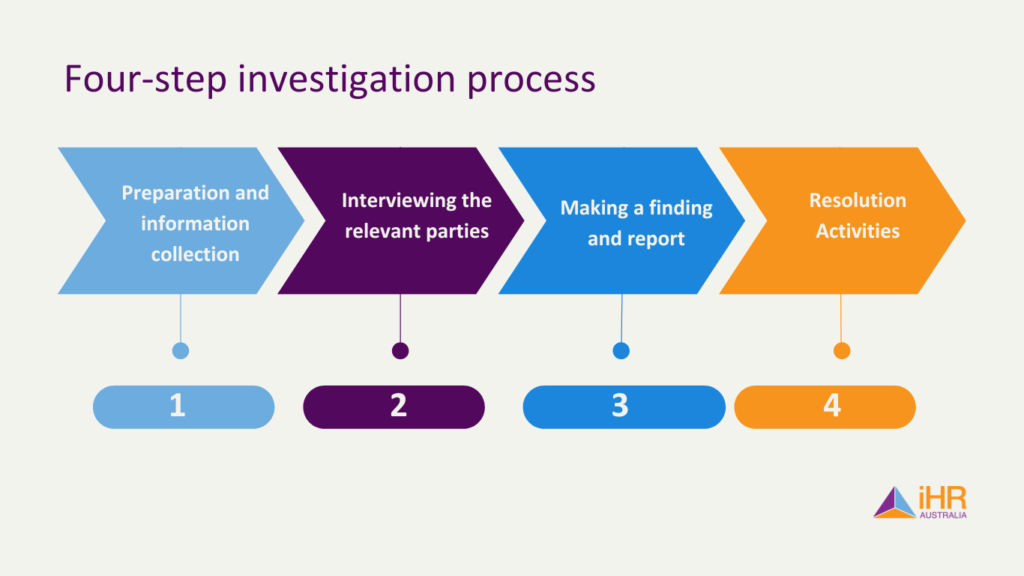Four step investigation process: Planning, Interview parties, Reporting, Resolution.
Article updated on 15 February 2024 [Originally published in 2017]
Workplace investigation process, whether conducted internally or externally, must follow a fair, objective, transparent and trauma informed manner. Procedural fairness is a fundamental aspect of the investigation process.
Hence, it is vital for organisations to engage competent and independent investigators who ensure confidentiality and have an impartial eye when analysing evidence relating to allegations of inappropriate workplace behaviour.
The first rule of thumb to running an investigation process is realising that ‘communication’ and ‘feedback’ to all parties concerned must be at the core of the entire process.
NOTE: This article should not be relied on as a complete step-by-step guide on how to conduct workplace investigations. A workplace investigation should be conducted by a suitably qualified individual or organisation.
Four-step investigation process: An overview

Four-steps to run a workplace investigation process
1. Preparing for a workplace investigation
When a workplace allegation involving inappropriate behaviour comes to light, here are a few things to keep in mind when planning to address the matter.
Following and an initial triage and a decision to proceed with a formal investigation process, the first and foremost thing is to consider whether you [as an investigator] are the right person to undertake the investigate, i.e., is there a conflict of interest and are you skilled and availability for the investigation?
Once this has been gauged, it is important to identify and categorise the nature of the complaint. Part of this involves:
- Identify the parties to the matter and their location and availability: Complainant(s), Respondent(s), Witnesses, or other interested parties [Unions etc]
- Obtain relevant background information available, which may include:
-
- Any relevant investigation protocols
- Complaint document(s)
- Relationships (organisational structure)
- Relevant policies and procedures and codes of conduct
- Relevant legislation including regulations
- Training records
- Position descriptions
- Employment contracts.
- Relevant industrial instruments if covered by an Award or Workplace Agreement and any relevant term(s) or obligations
- Past performance reviews / Employment records / CV’s
- How previous incidents have been managed, relevant operational processes and procedures
- Previous investigations / complaints / observed patterns of behaviour
- Environmental and psychosocial factors such as industrial climate, structural change operational pressures, threat of job loss, workload etc.
-
- Determine an appropriate location for interviews and administrative matters such as who organises the interview times. Take into consideration geographical factors for interviews such as work locations and travelling times, and availability of parties if involved in shift work, weekend work or currently on leave etc
- Consider representation matters i.e., union availability etc
- Be realistic in scheduling appointment times. Allow at least 2-3 hours with the complainant and a similar time with the respondent and 1 hour for each witness
- Determine who will be interviewed, and specifically in what order the will be interviewed
- Prepare key areas of allegations to question the interviewee about
- Develop and investigation plan and review the plan after initial interviews with the complainant(s) and the respondent(s)
- Allow for possible second interviews with both the complainant and the respondent to provide them feedback from the initial round of interviews and particularly around any conflict in evidence or statements that you do not feel have been supported in the investigation thus far.
2. Interviewing parties
When conducting interviews in an investigation process with the parties involved, it is imperative to start with an introduction of yourself and clearly outlining your role in this investigation process and asking if they have any questions regarding the process. An information sheet for the participants is good practice.
Here is a checklist of key steps in this second stage of the investigation process:
- Explain the role of a support person: Check that representation or support has been offered or if they have any special needs such as an interpreter and / or union representation
- Ensure the complainant understands the process and is aware of the relevant policies or options open to them in having their complaint handled
- Talk about the processes:
-
- Confidentiality – (also applicable to any support person) including the need to protect the integrity of the investigation process
- Communication of the particulars of any allegations with the respondent(s)
- Note taking, documentation, summary of interview notes or witness statements and / or the giving of permission to audio record the interview. Copies of notes and/or transcript should be provided to the interviewee for their verification
- Likely timing of the investigation moving forward
- Support services available to the parties by the employer
-
- Manage emotions and apply sensitivity: remember that the person may be emotional and/or mentally distressed. Suggest breaks if the interviewee becomes upset or distressed. The interviewer has a duty of care towards the person being interviewed and should not take an aggressive or unreasonable approach that feels like interrogation.
- Obtain as much specific detail (evidence) as possible:
-
- Description of behaviour – what was said/done and how often (what / who / when / where)
- List of potential witnesses, people the complainant may have spoken to about the complaint, or other people who may have experienced similar behaviour from the respondent but being careful not to unreasonably ‘embark on fishing expedition’
- Ask how they feel, what impact has the behaviour had on them (immediate and subsequent) and what they see as possible outcomes without giving them unreasonable expectations
- Filter the information being provided to see if it is going to be material to your findings (i.e. its probative value), check matters raised for currency, courts frequently do not admit evidence that may have occurred more than 12-24 months ago as it is difficult to revive memory about such events after that space of time. This may vary dependent on the nature of the allegation and any legislation involved
-
- Check appropriateness of existing work arrangements
- Explore the impact of environmental matters such as operational matters, organisational culture, training etc
- Check any ongoing support required e.g., Employee Assistance Program (EAP)
- Ask the interviewee if they have any further questions
- Explain timings and when you will get back to the interviewee
The approved Code of Practice, published by Safe Work Australia, covers sexual and gender-based harassment, and provides practical guidance to Persons Conducting a Business or Undertaking (PCBUs) on how to manage health and safety risks arising from sexual and gender-based harassment at work.
The Code also provides guidance on how to conduct an investigation process and respond to reports of Harassment.
3. Making a finding and report
Assess evidence based on:
- Consistency, reliability, and credibility of each party (how strong is the evidence)
- Balance of probabilities and reasonable person test – the more serious the implication of a finding the stronger the evidence needs to be
- Word against word evidence does not necessarily prevent you from making a finding or preferring one parties evidence over another party
- Impact on complainant, severity, and frequency of behaviour
- Whether the respondent intended to harass, discriminate or bully is largely immaterial in determining a finding
- Wishes of the complainant
- The safety of the parties
- Other factors outside of the parties making including any steps the organisation/management could or should have taken to prevent the matter from arising
- Policy contravention
- The impact on the organisation in terms of its exposure to vicarious liability claims and/or damage to its reputation
- Completing an Evidence Matrix may be useful in analysing information
For each element of the complaint, make a finding on the facts of:
- Behaviour found to have occurred
- Behaviour found NOT to have occurred
- Inconclusive due to a lack of evidence
Then categorise as:
- Breach of policy/code
- Unreasonable behaviour
- Unprofessional
- Reasonable in all the circumstances
Decision making
Do not leave any material matters unaddressed. A finding might be that there is insufficient evidence to support a finding of inappropriate behaviour or that the case against the respondent has not been established on the balance of probabilities. It is not fair to the respondent(s) to leave a matter unresolved.
Take one last look to see if the various elements of the complaint in totality establish a “pattern” of unacceptable behaviour.
Ensure a connection between the evidence and your findings and any subsequent conclusions so that your rationale is evident.
The Workplace Investigation Report
Evidence as to how the organisation dealt with the complaint may be reviewed in any subsequent legal proceedings. For example, if a complaint is lodged with the Human Rights and Equal Opportunity Commission or another anti-discrimination agency, records of internal action will be useful in establishing whether ‘reasonable steps’ were taken to deal with the discrimination / harassment and may assist in limiting the organisation’s liability, if any.
Finalising the Investigation Report
Before finalising the investigation, report and making findings (and if requested, recommendations), consider the following:
- Have all issues in the Terms of Reference been addressed?
- Have all respondents against whom an adverse finding might be made been advised of each relevant allegation and been given a chance to provide information in relation to the allegation?
- Have all relevant witnesses been interviewed?
- Have all witnesses interviewed had the opportunity to review and make any necessary corrections to their interview summary notes or statements
- Have all witnesses interviewed signed their Interview notes (typed up versions are preferable, however keep the original notes)
- Have copies of all relevant evidence (e.g., e-mails, photos, etc) which have come to light during the investigation been obtained?
- Where necessary, has any relevant evidence been put to witnesses?
- If the investigation has a crossover with workplace health and safety, has an WHS manager/expert been consulted or involved?
- Have you applied the balance of probability test when making factual conclusions, i.e., an investigator should not find a fact to be established unless it is ‘more probable than not’ that it occurred? (An Evidence Matrix Form is a useful tool to assist Investigators in this regard)
4. Resolution activities
Every situation is different so the suitability of resolution activities will also vary.
Examples of potential resolution actions include:
- Conciliation / mediation
- Counselling
- Formal apology
- Training
- Communication of policies to workforce
- Changes to team structure, job design, workloads, review of current policies and procedures and or SOPs
- Re-crediting any leave taken because of the discrimination or harassment
- Disciplinary action – e.g., warning, dismissal, transfer, demotion
- Dismissal of the complaint if it is found to have no substance
- Increased supervision / monitoring
- Reimbursing costs (e.g., medical, counselling etc)
- Disciplinary action against the complainant if complaint was found to be vexatious or frivolous
- Apply a review process if parties are not satisfied with the investigation outcome
Communication is an integral part of the investigation process
While an investigation process may meets all requirements, it is the perceptions of the individuals involved in a complaint that will influence their ability to accept an outcome.
A communication plan should be carefully considered and carried out at all steps of the investigation process.
Where to next?
Ensure you have received credible workplace investigations training before conducting any internal workplace investigation.
Get the conversation started about our workplace sexual harassment training available for:
Upskill your people with these topics
We have hand picked these training topics relevant to the above article.
Workplace Investigation Training
Understand the Fundamentals of Lawful Workplace Investigations In this program participants will be guided through the key principles of conducting a lawful workplace investigation, focusing on unlawful discrimination, bullying and…
Recent articles
![Lee Witherden v DP World Sydney Limited [2025] FWC 294 (2) Workplace policies](https://ihraustralia.com/wp-content/uploads/bb-plugin/cache/Lee-Witherden-v-DP-World-Sydney-Limited-2025-FWC-294-2-1024x539-landscape-dc731230e07743843bfa2c830cc42561-.png)
Smart Workplace Policies, Stronger Cultures: Compliance Made Clear





